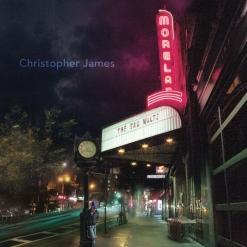
The Sad Waltz
Christopher James
2017 / Val Gardena Music
48 minutes
Review by Kathy Parsons
Anyone who has read many of my reviews has to know how much I love and appreciate music that cannot be categorized. With that in mind, I have to start this review by saying that Christopher James’ The Sad Waltz is about as out of the box as you can get - and I mean that in a very, very good way! I’ve been listening to this album for the past several days and finally got a chance to read more about Christopher James and his amazing background. An accomplished classical pianist, he earned a Bachelor’s degree in Music and German Literature, did graduate studies in Musicology, and then traveled to Germany for post-graduate research. He stayed in Germany for several years, composing and producing music for German films and television. Starting in 1988, he worked for PolyGram Records and quickly became the President of Classical and Jazz Music. During that time, he continued composing with his group, Val Gardena, and released three albums with them. He became CEO of Universal Music Group’s Classical and Jazz division, but has recently re-dedicated himself to his true passion of composing and making new recordings.
The music on The Sad Waltz was created while experimenting with composing for larger forms and as a challenge to compose more programmatically for an imagined visual environment. James composed the fourteen tracks, which were performed by a very impressive list of guest artists that includes his collaborators from Val Gardena, Jeff Leonard and Bob Stark. Some of the tracks are more on the pop side, some are more jazz, some have a strong classical influence, and some defy categorization.
The Sad Waltz begins with “Consequence of Intention,” an impressionistic exploration of harmonic relationships. More ambient than melodic, keyboards, electric guitar, and atmospheric sounds immediately make the listener aware that this album is going to be something different. “The Steppes of Mora” is much more classical and was inspired by the music of film composer John Barry - I love this one! “Ostinato for Piano, Percussion, Strings and Electronics” began as a piano improvisation and was arranged by Bob Stark for the ensemble on the album. There are so many things going on in this lively piece that it almost makes me dizzy, but it’s another favorite. “I Can See it Now” is a vocal piece and is a poignant look back at the relationship James had with his father. Anyone old enough to have watched television in the 1960’s and ’70’s has to remember the many shows that were produced by Quinn Martin, who had at least one show running in prime time from 1959-1980 - an industry record. “The Mighty Quinn (Martin)” is an homage to the wonderful scores from that era. “Claude’s Clouds” is an impressionistic solo piano improvisation that hints at Debussy. The title track is performed by the unlikely trio of piano, cello and accordion. Graceful and dreamy, it’s a lovely piece! There are two versions of “How Can I Change Your Mind?” The first is much slower with occasional vocals behind the piano, strings and light percussion. The second version, a closing bonus track, is much livelier and more upbeat - almost a rock instrumental and a great closer! “One Last Time” is a haunting and ethereal expression of the feelings experienced in the shared moments before a last goodbye. “Guardian Angel” was written as a thank you to Elton John. In the liner notes, James says: “His music gave me a context and provided a beacon of light that continues to be my north star.”
The Sad Waltz will definitely be on my list of Favorite Albums of 2017! It is available from Amazon and iTunes. I give it my highest recommendation!
July 27, 2017

2024
(contributing artist)

